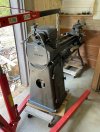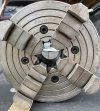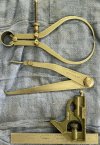Hey thanks Loren; I have a lot of new "techniques" to learn. My Precision Matthews small Lathe is a breeze to run, pretty straight forward. This one, to engage the Lead Screw you turn a smallish knob, tightening it and it engages the Lead Screw. Little things like that. But for a 70 year old Lathe, she it straight, easy to level and the Ways are without any "divits"; still see the original scraper marks. I've been wanting to build a moderator and in order to do that I will need to master the fine are of cutting precise threads. I still have to run a 220 line (~25' ) and I'm debating what size wire to use. I think I should be able to get it done with 12-3 w ground onto a 20 Amp breaker, however I'm not an electrician. Anybody with helpful advice, please chime in.
 All the tooling included was either Brown and Sharpe; Mitutoyo; Starrett. I'm glad I got her home.
All the tooling included was either Brown and Sharpe; Mitutoyo; Starrett. I'm glad I got her home.






